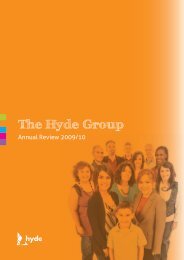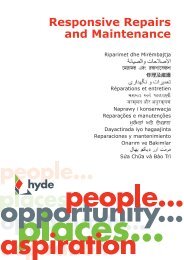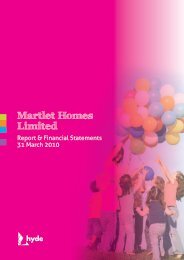Resident involvement - Hyde Housing Association
Resident involvement - Hyde Housing Association
Resident involvement - Hyde Housing Association
You also want an ePaper? Increase the reach of your titles
YUMPU automatically turns print PDFs into web optimized ePapers that Google loves.
<strong>Resident</strong> <strong>involvement</strong> in social housing in the UK and Europe<br />
recording its local activity. This was used to aid consistency and awareness<br />
across a large, diverse group.<br />
An example of a different ethos comes from E1, which had recently restructured<br />
after a series of mergers. It considered the idea of locally differing services at the<br />
behest of government (see Chapter 2) but firmly rejected it on the advice of<br />
residents. Here, the consumerist idea of a standard product that residents ‘buy<br />
into’ on the same terms wherever they are has taken root. Involved residents<br />
interviewed for this study were emphatic in their support for this approach: to<br />
do otherwise would in their eyes be unfair and unacceptable. In acting on this<br />
line of thinking, the only instance treated by E1 as ‘exceptional’ was a multilandlord,<br />
multi-tenure estate where residents were part of a larger <strong>involvement</strong><br />
scheme specific to the circumstances of that place.<br />
4.5 <strong>Resident</strong> <strong>involvement</strong> and organisational growth<br />
Especially conceptualised as citizens, a specific question about the remit of<br />
residents’ influence relates to decisions on organisational growth. Such<br />
decisions have a fundamentally ‘strategic’ rather than ‘operational’ character,<br />
whether they concern ‘incremental’ growth via new development or ‘en bloc’<br />
expansion via merger. An associated policy area relevant to many housing<br />
associations in England concerns ‘stock rationalisation’ – that is, reconfiguration<br />
of an organisation’s portfolio to reduce spatial dispersion and involving selective<br />
stock transfers to other providers.<br />
In England, the 2011 introduction of the ‘affordable rent’ funding system means<br />
that decisions on new development have taken on added significance for the<br />
tenant body. This is partly because the new framework involves newly built<br />
properties being let on an ‘affordable rent’ basis – i.e. with rents at up to 80% of<br />
market levels; considerably higher than as set under traditional arrangements.<br />
More importantly, the ‘affordable rent’ framework explicitly departs from the<br />
traditional model whereby scheme financing was ring-fenced within the new<br />
scheme itself. Reduced government grant per dwelling means that<br />
development can now proceed only where an organisation opts to ‘crosssubsidise’<br />
ongoing revenue costs of associated private finance by rent pooling.<br />
That is, contributing to the ongoing revenue costs of a new scheme via rental<br />
income derived from existing properties (in addition to those in the scheme<br />
itself). This is to be operationalised through ‘converting to affordable rent’ a<br />
proportion of existing homes being re-let. It has been estimated that for each<br />
dwelling newly built under this system, five existing properties will have to be<br />
re-let on an ‘affordable rent’ basis. This does not directly impact on existing<br />
tenants. Over time, however, the rental charge consequences of new<br />
38
















